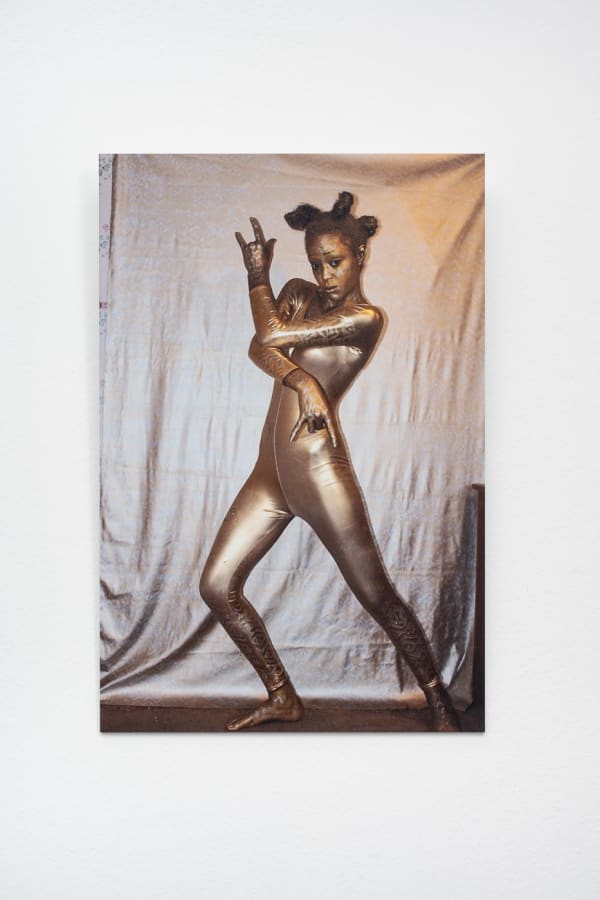-
I’ll Be Your Mirror
A solo exhibition with Abi Ola curated by Penelope Kupfer -
if mama
could see
she would see
lucy sprawling
limbs of lucy
decorating the
backs of chairs
lucy hair
holding the mirrors up
that reflect odd
aspects of lucy.
Lucille Clifton
For its next solo show, Kupfer is turning into a living room. Complete with chairs, curtains, lampshade, mirror, flower vase and table, Abi Ola invites us into her private world of patterns and portraits. Through a compulsive use of emojis, traditional West African fabrics, photography and British floral designs, Abi Ola’s works are a collection of personal chapters on identity, self-preservation, familial connections and pictographic forms of communication. Her paintings, textiles and sculptures rely on the relationship between shape and colour, from which she creates complex rhythmic structures drawing on simple, systematically repeated patterns. However, in her case, repetition does not function as a study or a tool used for emphasis or depuration purposes, but as a form of distortion or distraction.
Having to navigate the world from a place of neurodiversity, Abi’s practice reflects her need and desire to welcome people into her private sphere whilst also protecting herself. Her most recent works resort to the repeated use of mirrors and metallic materials. Mirrors are both reflecting and distracting; we look at them as an attempt to decipher the many ways our selves are shaped by internal and external forces, revealing the unavoidable juxtaposition between our self-image and the gaze of others. Her work invites the viewer to engage with her choice of reflective materials as if by saying, in no particular order: don’t look at me, look at you, or don’t look at you, look at me. We see the mirror, and the mirror sees us.
-
 Abi OlaBouquet 1, 2022Oil, oil pastels, screen print, spray paint, and fabrics on canvas160 x 110 cm
Abi OlaBouquet 1, 2022Oil, oil pastels, screen print, spray paint, and fabrics on canvas160 x 110 cm -
 Abi OlaReflective Hands and Feet, 2022Oil, oil pastels, acrylic, fabrics, and screen print on canvas60 x 60 cm
Abi OlaReflective Hands and Feet, 2022Oil, oil pastels, acrylic, fabrics, and screen print on canvas60 x 60 cm -
Good mirrors are not cheap, says Audre Lorde, it is a waste of time hating a mirror or its reflection.¹ By lining the gallery with canvas and turning her world of patterns back onto us, the artist invites us to face up to our own image in her portraits and living room. Whilst the echo of emojis cannot but distract the message, the mirror distorts the image – hers, her subjects’ and ours. Abi Ola could be hiding behind her mirrors but she is also reflecting outwards.
¹ Audre Lorde, “Good Mirrors are Not Cheap” (1970) from The Collected Poems of Audre Lorde, 2000
Written by Adriana Francisco -
-
 Abi Ola, A Look Into the Mirror, 2022View more details
Abi Ola, A Look Into the Mirror, 2022View more details -
 Abi Ola, Silver Hands, 2023View more details
Abi Ola, Silver Hands, 2023View more details -
 Abi Ola, Emerging Head, 2023View more details
Abi Ola, Emerging Head, 2023View more details -
 Abi Ola, Bathing, 2023View more details
Abi Ola, Bathing, 2023View more details
-
 Abi Ola, Bouquet 1, 2022View more details
Abi Ola, Bouquet 1, 2022View more details -
 Abi Ola, Bouquet 2, 2022View more details
Abi Ola, Bouquet 2, 2022View more details -
 Abi Ola, Reflective Hands and Feet, 2022View more detailsSold
Abi Ola, Reflective Hands and Feet, 2022View more detailsSold -
 Abi Ola, Walking Through Weeds, 2022View more details
Abi Ola, Walking Through Weeds, 2022View more details
-
-
Abi Ola, Patterns in my living room, 2021 - 2023
-
About the artist
Abi Ola (b. 1996, London) is an artist living and working in London. She graduated with an MFA from the Slade School of Fine Art (2021), and has a BFA from Goldsmiths (2019). She was recently granted the New Contemporaries Award 2022. Her solo shows include Kaleidoscopic Bodies (2022) at Frans Kasl Projects, in Eindhoven, Netherlands, and All Are Gone The Old Familiar Faces (2022) at Flatland Projects, Bexhill-on-Sea, UK. She had a group exhibition at Rawlinson & Hunter alongside the Ingram Prize alumni, and a group show at Christie’s, London, as part of the Good Eye Projects Residency, both in 2022.


















